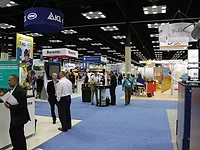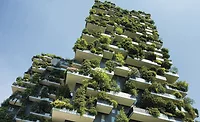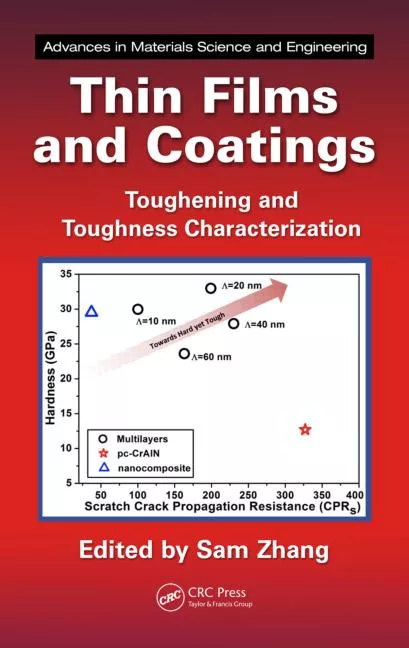Laser-Focused on Sustainability

Image Copyright: NürnbergMesse GmbH
By all accounts, the 2023 European Coatings Show held in Nuremberg, Germany, was highly successful for all who participated. Sustainability and reducing the global carbon footprint dominated every conversation. I was able to meet with quite a few suppliers at the event, who showcased the latest innovations available to help coatings manufacturers and end users meet performance and sustainability targets. I share some of the technologies that I learned about in the article below.
Arkema's New Collaborative Approach to Sustainability
During the ECS, Arkema hosted a leadership panel titled “Sustainability and Market Transformation,” where they were joined by industry leaders in sustainability from Perstorp, PPG, the European Association of Chemical Distributors, and OMYA.
“To accomplish real change, we have to adapt how we work. Alongside leading companies throughout the value chain, we are focusing on connecting the downstream consumer and market expectations, to the upstream innovation capabilities; working together to improve every sustainability aspect of the industry,” said Richard Jenkins, Senior Vice President, Arkema Coating Solutions.
These leaders from across the value chain discussed and collaborated on the most innovative solutions needed to meet consumer expectations for a more sustainable lifestyle; and addressed tomorrow’s challenges such as climate change, resource scarcity, urbanization, and technology transformation. Starting with brand owners’ vision and commitments to evolving consumer and industry expectations, Arkema’s coating and its Bostik adhesive solutions’ experts – together with their guest speakers – discussed new ways and specific examples of meeting these trends through a more connected value chain ecosystem.
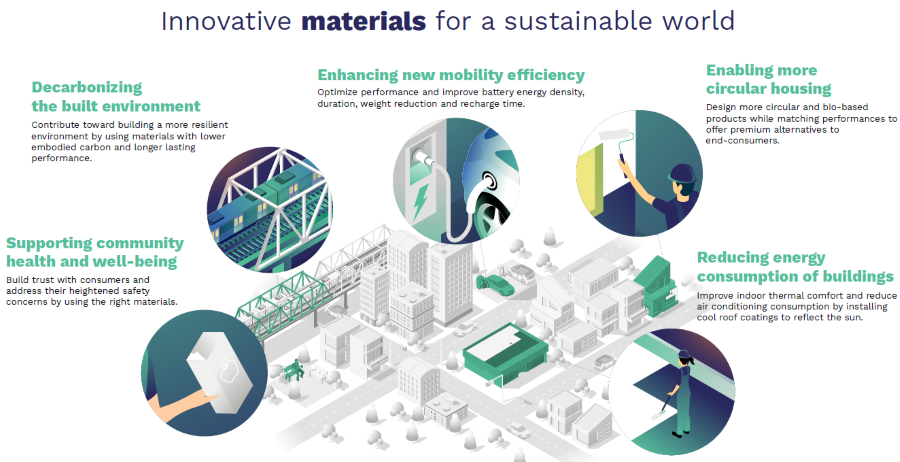 Image courtesy of Arkema.
Image courtesy of Arkema.
At their booth, Arkema showcased its new sustainable offerings for the industry, and provided answers to emerging markets like home efficiency, more circular housing, community well-being, decarbonization of the built environment, and more.
Key featured innovations included:
· Cool surfaces painted white, enabling reduced air conditioning usage;
· Development of UV coil coating technology;
· New low-temperature-cure powder coating resins for industrial medium density fiberboard (MDF) applications;
· Extension of biobased and biomass balance specialty resins and additives, enabling more circular housing applications;
· New UV/LED-curable and waterborne solutions to develop safer inks and coatings for packaging.
Arxada's Advanced Solutions for Coatings
Built on the legacies of Troy Corporation and LSI, Arxada presented its combined portfolios of preservation technologies, as well as the value-added services, resources, and other benefits that this joining of forces brings to customers. These include global regulatory assistance and comprehensive technical services, including microbiological and field testing, R&D and analytical support, and the unique TMMA (The Microbial Management Advantage) plant hygiene program. The company also highlighted its focus on innovation and sustainability.
Arxada’s combined portfolio of preservatives and additives offers a wide array of active chemistries and formulated products to give customers flexibility. The company featured its advanced TIME controlled-release dry-film preservatives, a suite of latest-generation encapsulated antifungal and antialgal products engineered to provide balanced protection over time, reduce leaching into the environment, and maximize safety, handling, and environmental advantages.
Azelis' Innovative CASE Formulations
Azelis’ presence in the CASE market has significantly expanded over the past few years through investments, acquisitions and organic growth in EMEA. The group’s substantial growth and significant investments in its laboratory network, including the most recent CASE laboratory in Istanbul, demonstrate its commitment to delivering innovative solutions for the CASE industry through a comprehensive product portfolio.
For the ECS, the CASE application laboratories in Turkey and Germany collaborated with regional marketing and business development teams to develop ground-breaking formulations. The Azelis CASE team presented high-performing materials from key principals that reflect market trends toward energy efficiency and sustainability.
Combining technical expertise with sustainability and efficacy, the five formulations displayed were waterborne coatings and included an innovative, energy-saving, direct-to-metal coating. The formulations covered various CASE applications, from antislip and chemical-resistant coatings to decorative and easy-clean paints.
BYK's Biobased Additives
Sustainability has been a key driver for many years for BYK in its development of new additives. In addition to the obvious properties and effects of the product, questions regarding environmental impact, chemical basis, and energy consumption play a central role. At the ECS, BYK presented three additives from the CERAFLOUR product line that meet these requirements.
With the introduction of CERAFLOUR 1003 and CERAFLOUR 1004 – two corn starch-based polymers with wax-like properties – BYK has further expanded its portfolio of sustainable additives. Both additives ensure good matting while maintaining high transparency.
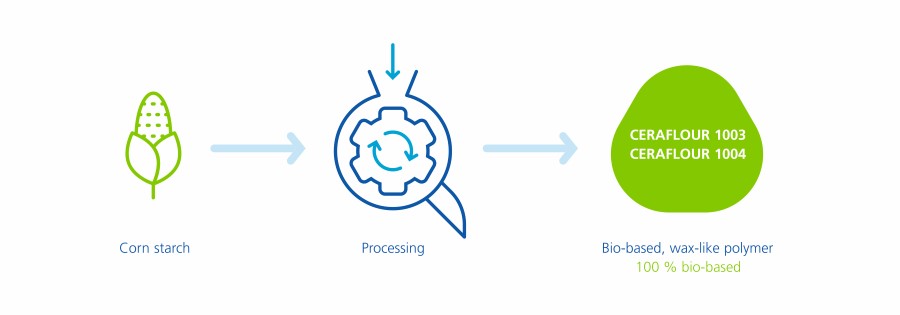 Image courtesy of BYK.
Image courtesy of BYK.
CERAFLOUR 1003 gives a slight surface texture and provides a similar matting effect at different observation angles, and is especially recommended for wood and furniture coatings as well as for architectural coatings.
CERAFLOUR 1004 has finer particles and results in a slight matting effect in combination with high transparency and a smooth, soft, and silky surface feel. It is recommended in wood and furniture coatings, in coil coatings and in architectural coatings.
CERAFLOUR 1010, another new biobased additive, was also showcased. This micronized wax – based on rape seed – offers excellent matting efficiency and very good mechanical resistance. This makes it ideally suited for modern wood coating systems such as natural-look formulations, for use in general industrial coatings and in architectural coatings.
Chemours' New Track & Trace Technology
The Chemours Company launched Track & Trace, an innovative order tracking technology that provides Ti-Pure™ Flex and Connect customers with real-time visibility into their order location and status directly from the eCommerce portals.
This technology provides step-by-step shipment updates, empowering Ti-Pure customers with improved visibility and supply reliability. Similar to consumer eCommerce delivery tracking, Ti-Pure Flex and Connect customers can access up-to-the-minute delivery information that adds transparency and efficiency to their supply chain and production processes.
“Chemours Titanium Technologies is committed to customer-centered innovation, and that extends beyond our product portfolio to every aspect of the customer experience, including logistics and final-mile delivery,” said Aditya Beri, VP of Titanium Technologies Supply Chain & Minerals at Chemours. “With Track & Trace, our Ti-Pure Flex and Connect customers can operate with greater clarity and confidence when it comes to pigment deliveries, which is critical in today’s environment where supply chain issues can cause ripple effects across industries.”
Clariant Extends Support for Navigating Coatings Challenges
Clariant hosted an interactive press conference at its ECS booth. To kick things off, Business Unit President Adsorbents & Additives, Angela Cackovich, discussed the company’s focus on sustainability, and its innovative and sustainable technologies developed to reduce environmental impact while maintaining top-quality coatings. “We strive for sustainability leadership in all that we do,” she stated.
Following Cackovich’s comments, attendees were introduced to a collaborative project between Clariant and Omya. The two companies joined forces to tackle customers' concerns related to the yellowing of the increasingly popular SMP (silane-modified polymers) sealants. The results of their collaboration - AddWorks IBC 760 - addresses the yellowing issue, while delivering a label-free solution with higher light and heat performance versus standard solutions in the market.
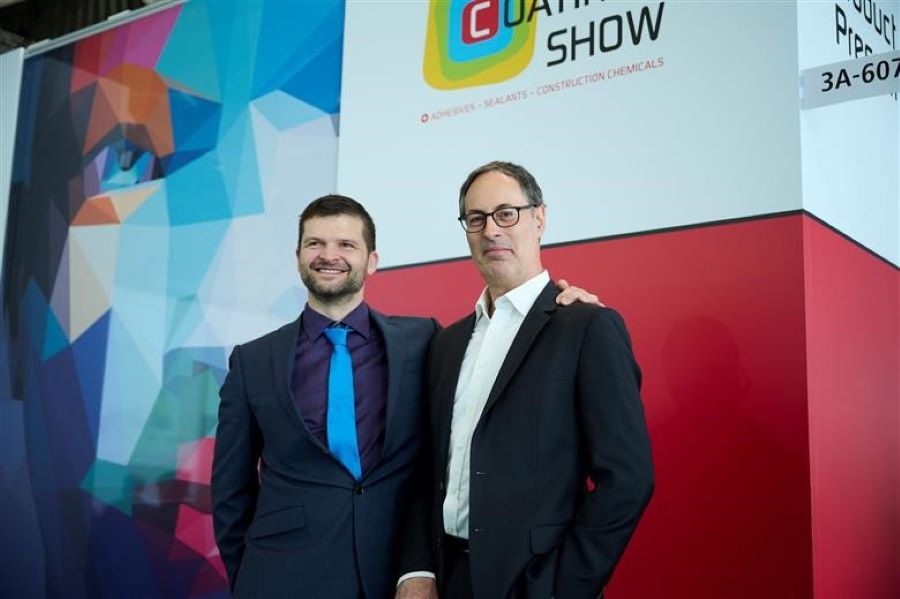
From left to right: Christopher Dobbins, Application Manager Adhesives & Sealants from Omya and Jean-Yves Desrats, Senior TechnicalBusiness Development Manager Coatings & Adhesives from Clariant.
“With the increased focus on raw material regulatory issues, and a need for manufacturers to create longer-lasting products that help them differentiate and drive innovation toward more sustainable products, it was crucial to also consider these evolving priorities with Clariant in developing a new stabilizer solution,” commented Martin Oktai, Director Global Additives at Omya.Clariant’s AddWorks IBC 760 is at its core a hazards-free light and heat stabilizer package proven to meet or exceed the performance of benchmark solutions in SMP sealant formulations. By adding Hostanox O 3 P, the formulator can boost the weathering performance and heat stability even further. This allows for the development of a wider range of sealants for different customer requirements and applications.
“This innovation really captures the value of listening, collaborating, and applying learnings, within our whole way of working,” commented Martin John, Global Vice President Segment Coatings & Adhesives, Clariant. “By addressing one unmet need from SMP sealant manufacturers, the market has gained a label-free light and heat stabilizer package that meets the initial target of no yellowing and exceeds the performance of current solutions on the market. These benefits are now being evaluated for coatings systems, demonstrating that technologies in one market segment may prove beneficial in other application areas.”
Clariant also launched a new package for the coatings sector that assists in the research of additives compliant with the most relevant food contact regulations. There are three key complementary elements to the new package, ensuring different views and areas of focus, providing a holistic approach with easy access to information in one place. It includes an interactive selection tool, an overview table, and food contact reports with detailed regulatory information such as Substance Migration Limits (SMLs).
The interactive tool allows customers to select most relevant regulations and find compliant additive products out of the Clariant portfolio. These search results link directly to individual product pages that also give access to food contact reports with comprehensive details on each additive. In addition, a downloadable selection guide is available to offer users a standardized solution where all screened products and regulations are shown in a table format.
“Safety and regulatory compliance are important criteria when you choose ingredients, and at Clariant we want to give you the confidence to select our products when it comes to food contact applications,” said Sebastian Prock, Clariant’s Head of Global Marketing Industrial Applications.
Elementis Expands RHEOLATE® Powder NiSAT Range
Elementis has expanded its product portfolio of 100%-solid urethane rheology modifiers with the new RHEOLATE PHX 7025. The expansion of the patented RHEOLATE Powder NiSAT range exemplifies the company’s commitment to use rheology science to develop sustainable solutions that outperform conventional market alternatives. Elementis successfully designed a full-shear range of powdered versions of urethane rheology modifiers, suitable for safer, high-performance and more sustainable formulations.
“The paint and coatings industry is constantly seeking higher performing, safer and more sustainable solutions,” said Gerjan van Laar, Global Marketing Segment Manager Architectural. “At Elementis, we understood that our urethane rheology modifiers could offer the needed improvements, and successfully designed a 100%-active powdered version of our urethane rheology modifiers, RHEOLATE Powder NiSAT range, suitable for high-performing formulations,” added Carlos Feito Fraile, Technical Director Performance Specialties.
The product range can easily be incorporated into a variety of paint and coating formulations, resulting in improved handling, increased efficiency, and meeting the latest eco labeling requirements.
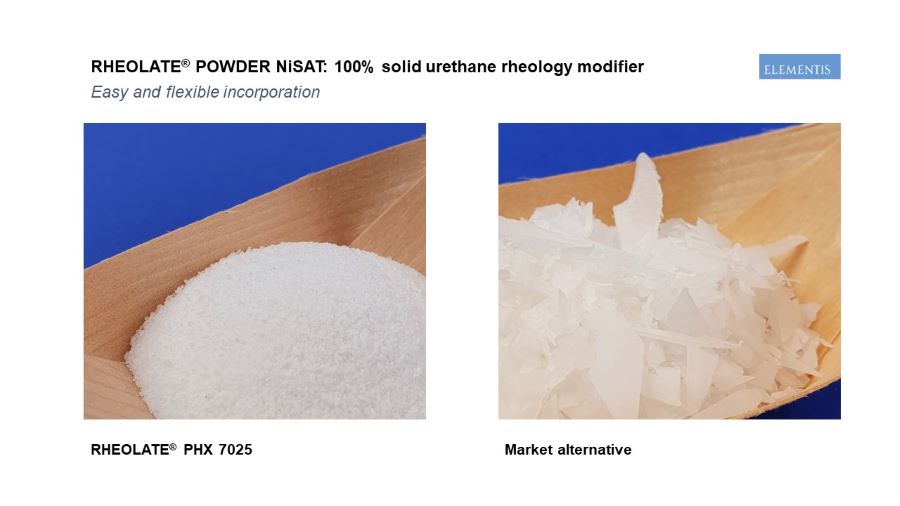 Image courtesy of Elementis.
Image courtesy of Elementis.RHEOLATE Powder NiSAT provides great advantages regarding the health and safety profile of paints. Due to the 100%-solid form, biocides are not needed, and it requires no emulsifiers or surfactants, resulting in a VOC-free product range. Furthermore, the products are free of any hazardous labels. Powder thickeners allow paint manufacturers to formulate asthma- and allergy-friendly paints, and help them attain EU Ecolabel, Nordic Swan, Blaue Engel, Asthma Allergy Nordic and French NF Environmental certificates.
The new product also realizes up to 80% CO2 reduction on transportation due to the fewer transportation movements that are needed. The 100%-solid form avoids shipping water around the globe, and therefore makes a positive impact from a sustainability point of view. Next to that, it also reduces storage space in warehouses, and it is less sensitive to low temperatures regarding storage and transportation.
EPS® Launches Three New Polymers
Engineered Polymer Solutions launched EPS 2585, a high-solids waterborne acrylic emulsion that provides the capability to formulate direct-to-metal applications at <100 g/L VOC. EPS 2585 is recommended for high-performance general industrial and railcar coatings with excellent hardness, block resistance, and early water resistance.
"There's a growing demand for DTM coatings that meet tough performance requirements," said Robert Sandoval, Ph.D., R&D Technical Director for Engineered Polymer Solutions. "Extensive research went into developing EPS 2585 to achieve the ideal balance of properties that the market requires."
Coatings formulated with EPS 2585 help optimize the coatings process by eliminating the priming step, helping manufacturers save time and money while extending the life span of their coated products.
"This polymer is well suited for exterior applications due to its exceptional gloss retention and multisubstrate adhesion," mentioned Chris LeFever, R&D Technical Manager for EPS. "With EPS 2585, we offer superior corrosion resistance without the use of anti-corrosion pigments, even at film builds as low as 1.5 mils."
EPS also launched EPS 2786, a new all-acrylic polymer for high-performance gloss interior and exterior architectural DIY or professional paints.
 Image courtesy of EPS.
Image courtesy of EPS.This versatile polymer is recommended for use in semigloss to high-gloss enamels that require exceptional hardness and tack resistance in both white/pastel bases and fully tinted clear/neutral bases. It is ideal for institutional, commercial, or other high-traffic areas.
“Formulators often use migrating species, including waxes and polyfluoroalkyl substances (PFAS), specifically fluorosurfactants, to achieve block resistance. PFAS have come under increased scrutiny by the United States Environmental Protection Agency (EPA) and regulators worldwide due to environmental and health concerns,” says Robert Sandoval, Ph.D., EPS R&D Director. “Coatings formulated with EPS 2786 are capable of achieving same-day hot block resistance (50 °C) within hours of being applied, without the use of intentionally added fluorosurfactants.”
EPS 2786 also offers exceptional exterior durability and dirt pickup resistance; rapid hardness development; gloss retention in both accelerated QUV-A (ASTM G154) and natural exposure testing; washability and scrub resistance (ASTM D2486); as well as abrasion resistance.
A third product launch was EPS 2436, a new self-crosslinking acrylic dispersion for use as a binder for high-quality wood coatings. It joins the EPS 2400 series, a line of waterborne acrylic resins that wood coating formulators can use to develop high-performance solutions for industrial applications, cabinetry, furniture and flooring. This new product offers exceptional transparency when dry and excellent block resistance.
“Coatings formulated with EPS 2436 offer enhanced properties in interior wood applications such as excellent chemical resistance and rapid hardness development,” said Lynn Spataro, EPS Global Vice President. “The rapid hardness development helps streamline production and reduce manufacturing times. EPS 2436 also provides a low-VOC waterborne alternative to legacy solventborne technologies.”
Evonik Invites Customers to “Formulate the Future”
Evonik presented its latest solutions for the coatings, inks, and adhesives industries. The specialty chemicals company focused on how it can help its customers "Formulate the Future." To create truly "future-proof" formulations, Evonik's latest solutions improve both the performance and the sustainability profile of an end product. Highlights include innovations for architectural, automotive, marine, infrastructure, packaging, wind energy, and wood and furniture surfaces.
“Modern coating and adhesive products should be innovative and customized, as well as based on renewable raw materials to make them more resource-efficient and environmentally sustainable,” said Claudine Mollenkopf, President Division Specialty Additives. “With our technical expertise, we are helping our customers develop solutions that are fit for the future.”
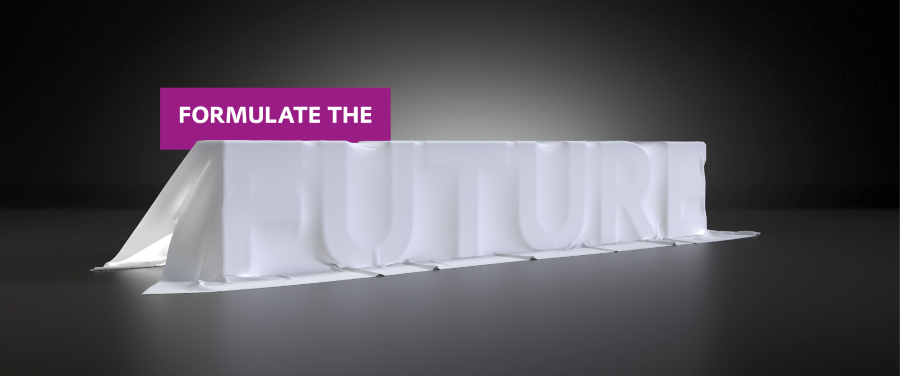 Image courtesy of Evonik.
Image courtesy of Evonik.
Some of Evonik's notable innovations that were highlighted included:
• Smaller sized silica for increased durability of clear and pigmented coatings: SPHERILEX® DP-0110 provides gloss control for matte or satin finishes and improved durability of architectural and wood coatings.
• Solutions for visually appealing automotive and wood coatings: TEGO® Wet 290 and TEGO Wet 296 improve wetting and anticratering properties for better leveling of waterborne automotive and wood coatings.
• Ultralow-VOC and biobased epoxy curing agents: Ancamine® 2739, 2712M, and 2802 offer an ultralow level of VOCs, fast curing times, and enhanced UV durability to protect architecture and infrastructure on land and sea. Using raw materials derived from 40-45% biobased sources, Ancamine 2719 provides sustainable, fast-curing protection for marine metal coatings, potable water, and food applications.
• Environmentally benign catalysts: POLYCAT® SA 2 LE and DABCO® 8174 tin-free heat and delayed action catalysts contain no CMR components and low VOCs, making them ideal for adhesive, sealant, and elastomers where improved labeling, lower hazard profile, and high sustainability are desired.
• Bio-based diamine curatives: VERSALINK® EP-P-170 is an easy-to-process liquid at room temperature and contains over 80 wt.% biorenewable content, helping reduce the carbon footprint of the final product by 30 to 35 wt.% when used as a curative in polyurea repair coatings, adhesives, and elastomers, where performance and sustainability matter.
• Certified, carbon-footprint-reduced methacrylate monomers: VISIOMER® Terra products have a biocarbon content of up to 85%, certified according to the international standard ASTM D 6866. They provide sustainable and environmentally friendly building blocks for high-performance polymers.
• Environmentally friendly ethoxy silane adhesion promoters: VPS SIVO 350-1 shows excellent adhesion and mechanical properties and good flexibility in cured SMP and silicone systems such as hard parquet adhesives.
• Modern anticorrosive coatings: VPS SIVO 240 is a 2-in-1 additive that offers long-lasting protection and makes low-solvent or solvent-free paints easier to process, reducing VOC content making them more sustainable.
New Heubach Group Introduces a Range of Products
One year after Heubach and Clariant BU pigments joined forces, the new Heubach Group held a press briefing at the ECS, and unveiled an innovative range of new products and tools at their booth.
At the briefing, Heubach’s CEO, Dr. Stefan Doboczky, stated that the pigment industry is at a turning point. The industry is financially stressed; the geopolitical developments require pigment supply chain executives to reconsider their choices; and the environmental footprint is very intense. He noted that the industry is absolutely challenged, and needs to innovate, and “shape up” on issues such as CO2 and other emissions, circular models, and transparency and traceability.
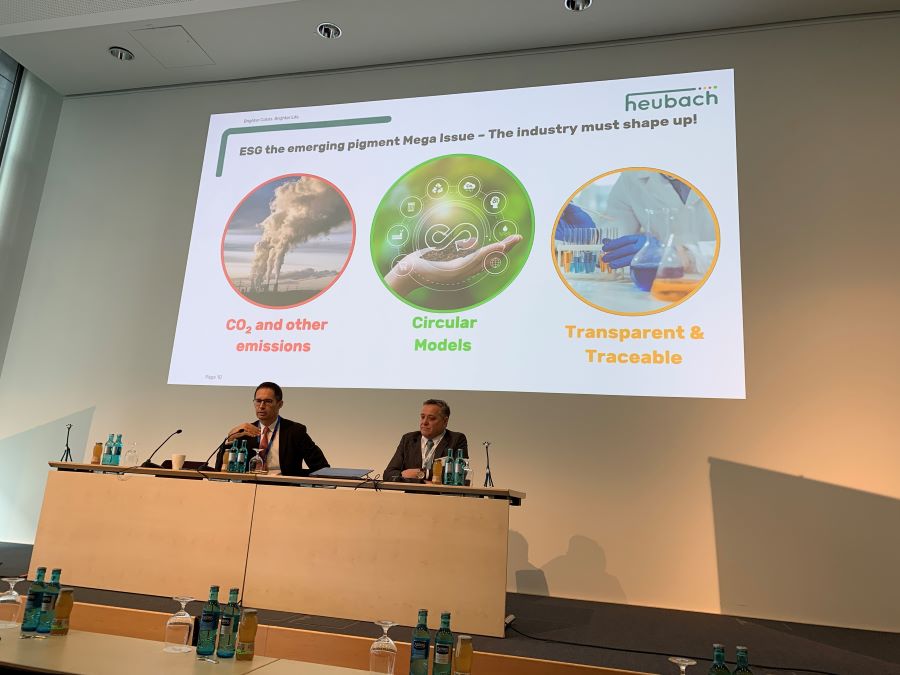 Heubach's CEO, Dr. Stefan Doboczky (left) and Head of Marketing & Sales, Alexandre Baron (right).
Heubach's CEO, Dr. Stefan Doboczky (left) and Head of Marketing & Sales, Alexandre Baron (right).
With a focus on advanced sustainable color technology, visitors to the Heubach booth learned about new water- and biocide-free pigment preparations. This is a revolutionary and sustainable solution for interior decorative paints.
Heubach’s new generation of highly effective zinc-free anti-corrosive pigments, Heucosil™ CSA and CSM, meet the specific performance requirements for coil- and thin-film-applications. These products show outstanding corrosion protection performance and a significantly low oil absorption.
Also launched was the recently developed Heucodur® Green 630, a new nonlabelled spinel green pigment based on the historically known chrome-free composition, as well as Hostatint™ UV 100, a reformulated and reimagined range of pigment preparations for radiation-cured coatings - a safer and more sustainable way to add color and vibrance to wood finishes.
Additionally, the company also showcased the latest edition of its automotive color previews with the Automotive Styling Shades 2027 Trendbook, “Plan B for Planet A.” In doing so, the new Heubach Group continues Clariant’s BU Pigments tradition of the biennial color trend forecasting of the “Automotive Styling Shades Trendbook” series. The 2027 Trendbook is entirely digital, easily accessible on Heubach´s website, and linked with the innovative Car Color Configurator. Readers can select the type of vehicle and the scenery in which the 28 trend colors are displayed and download their individual version.
The Plan B for Planet A also includes a lower footprint of pigment production, safer and easier-to-use products, and improved color formulations. The merger of the high-performance pigment ranges from Heubach and Clariant BU Pigments expands the accessible color space, while the shared formulation know-how helps to improve the visibility of vehicles by RADAR and LIDAR sensors which is a prerequisite for autonomous driving.
“Our 2027 Trendbook is not only about nice colors and how our Planet A should be treated and run, but also about sharing ideas and information of state-of-the-art production and synergized use of color itself,” said Bernhard Stengel-Rutkowski, Senior Technical Manager of Heubach´s Global Technical Marketing Coatings and Color Formulator.
Hexigone's ‘Chemically Intelligent” Corrosion Inhibitors
Hexigone Inhibitors exhibited its ‘chemically intelligent’ anticorrosives, which have recently been awarded the prestigious Gold Sustainability Rating from Ecovadis. This result places the company among the top 5 percent of companies assessed by the organization globally.
To achieve the Gold Rating, Hexigone had to undergo an in-depth evaluation from EcoVadis who evaluate the quality of the sustainability management system through four assessment pillars: environment, ethics, sustainable procurement and labor and human rights.
Marc Phillips, Operations Manager at Hexigone commented, “We are pleased that Hexigone was awarded the gold sustainability rating from EcoVadis at first entry and evaluation, as sustainability is at the core of Hexigone’s product offer. We have robust policies and procedures in place and will also be utilizing our scorecard to improve business processes further. Our goal is to reach the platinum rating next year.”
Hexigone’s corrosion inhibitors were brought to market to replace heavy metals, phosphates, and toxic chromates with highly effective, environmentally favorable inhibitors. 40% of all new steel created is used to replaced steel damaged or destroyed by corrosion. The superior protection offered by Hexigone’s Intelli-ion® technology increases the product lifecycle of metal assets - reducing the drain on primary resources.
IFF's Naturally Derived Solutions
IFF showcased its comprehensive industrial solutions polymer portfolio with green chemistry-based materials. Visitors were able to discover IFF’s broad range of customized, environmentally friendly solutions to address coating and printing ink formulation and manufacturing challenges. Solutions include how to potentially improve coating functionality, increase savings, and improve worker safety – while supporting sustainable and biobased solutions.
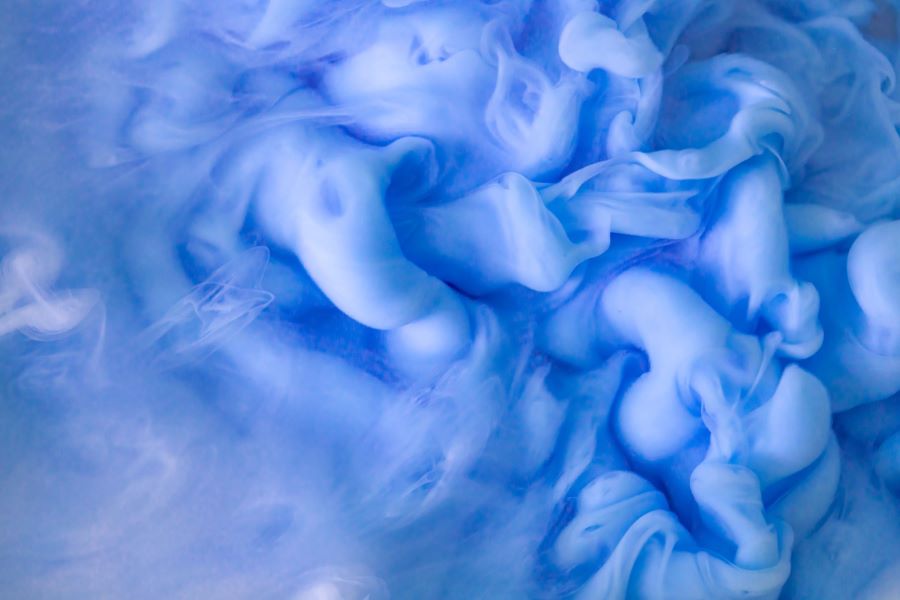 Image courtesy of IFF.
Image courtesy of IFF.
The company’s range of renewable polymer solutions for sustainable coating, adhesive, paint or ink products includes:
• Lattice® NTC colloidal microcrystalline cellulose: a functional fiber that improves formulation stability with low viscosity. It is biodegradable and allows greener paint and coating formulations.
• WALSRODER™ nitrocellulose (NC): a leading brand for printing inks, wood coatings and varnishes. IFF’s free-flowing NC grades are packed with an automated emptying device that allows for an extremely short emptying time (15-25 seconds per drum) and eliminates the need to manually lift a drum, resulting in higher output, production efficiency and improved worker safety.
• POLYOX™ polyethylene oxide: a water-soluble thickener, binder, film-forming polymer that improves adhesion.
• ETHOCEL™ ethylcellulose: a thickener and binder for solvent-based paints, wood coatings, and printing inks, enabling reliable performance.
• TEXTURECEL™ carboxymethylcellulose: a thickener and binder in water-based coatings and ink formulations. It offers thickening and rheology modification properties, and is an extremely versatile and economical product. It is also a natural alternative to synthetic polymers.
• METHOCEL™ cellulose ethers: a key formulation component in paint removers. They are versatile due to their solubility in water and many organic solvents.
“Our portfolio consists of several products with a positive sustainability profile,” said Christophe Massip, Marketing Director, Industrial Solutions, IFF. “We’re committed to be the partner our customers can count on, by delivering quality through our operational excellence and formulation expertise. Our goal is to partner with our customers, providing novel and greener alternatives to help reduce the environmental footprint of their end products.”
LANXESS' Extensive Range of Products and Services for the Coatings Industry
Specialty chemicals company LANXESS showcased its product portfolio for the manufacturing of high-quality coatings. This includes biocides, ecofriendly colorants, plasticizers, coalescents, and flame retardants as well as aqueous polyurethane dispersions and urethane prepolymers. Another highlight in terms of sustainability is that for many of its iron oxide pigments that are used in common paint systems, LANXESS now offers environmental product declarations (EPDs). High-quality basic chemicals such as benzyl alcohol and benzoic acid complete the portfolio for the coatings industry.
The focus at ECS was on the enhanced range of preservatives for comprehensive material protection. Monika Lamoratta, Technical Manager at the LANXESS Material Protection Products (MPP) business unit, said, “For us, responsible material protection is more than just preservation because biocidal substances are increasingly coming under pressure due to regulatory changes. With our products Bioban DB20 and Preventol OX, we are helping manufacturers to keep their production activities clean and become more sustainable overall. Our innovative technologies help to quickly identify critical areas in production that are predestined for microbial contamination – on-site and in the laboratory.”
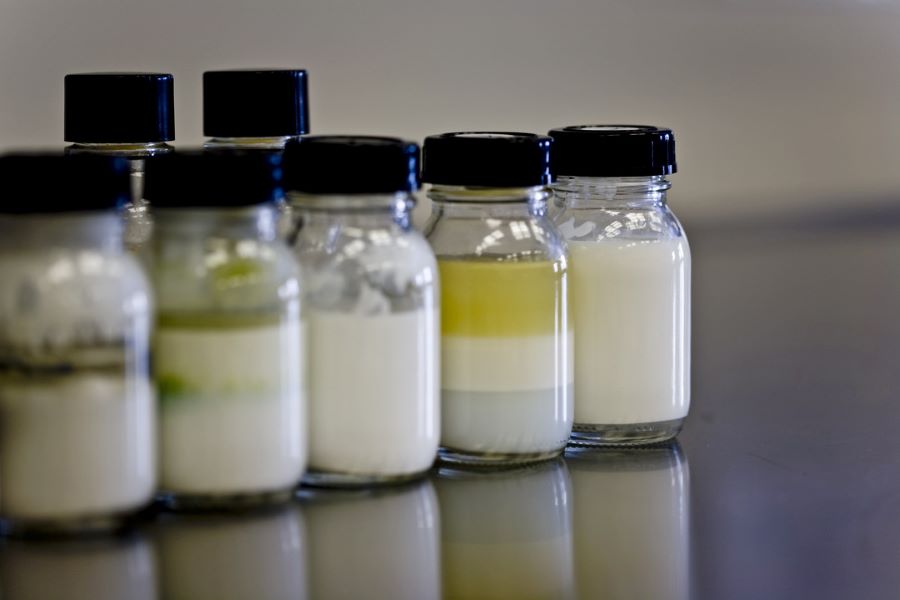 Image courtesy of LANXESS.
Image courtesy of LANXESS.
Inorganic pigments from LANXESS are once again setting a new benchmark in terms of sustainability: In the future, the company will be offering environmental product declarations (EPDs) for all Bayferrox-branded products manufactured at its main production site in Germany – the first manufacturer of synthetic iron oxide pigments to make such an offer. These declarations describe and verify construction materials, products, or components in terms of their environmental impact. By providing them, LANXESS is creating a high degree of transparency for its customers. The parties who will benefit from this the most are manufacturers of paints and coatings, who – as part of their sustainability strategy – are optimizing their value chains by using sustainable raw materials.
The Urethane Systems business unit also put forward an extensive product portfolio for the paint and coatings industry. One focus was on raw materials for formulating aqueous systems for a wide range of applications – from glass-fiber sizings and plastic coatings, through to textile finishing or vehicle paintwork.
The Trixene Aqua BI products serve as excellent crosslinkers and adhesion promotors for aqueous coating systems. They improve the chemical and mechanical resistance not only of highly flexible textile and fabric coatings, but also of coatings for rigid substrates.
In addition to Trixene Aqua, LANXESS offers a full range of water-based polyurethane dispersions (PUDs) with its brand Witcobond. These products can be used for many applications, such as for water-based coatings and finishes for both hard and flexible substrates with a low proportion of volatile organic compounds (VOCs).
Products from the Pellart brand are used in numerous functional coatings that are subject to stringent requirements in terms of their feel, chemical resistance, luster, temperature stability, and abrasion resistance. In particular, the Pellart range really comes into its own when minimal VOC content is required.
High-quality, erosion-resistant coatings can be created using the prepolymers from the Adiprene and Trixene ranges. For example, Adiprene LFH C840 (HDI) is used for turbine blades, and Adiprene LW 520 (H12MDI) is predestined for coating aircraft wings as well as helicopter rotor blades or wind turbines.
In its wide range of colorants, the Colorant Additives business – which is part of the Polymer Additives business unit – offers aqueous pigment dispersions under the brand names Levanyl (organic) and Levanox (inorganic). These products combine high tinting strength, low viscosity and are binder-free.
Products from the Disflamoll brand offer effective flame retardance. The phosphorous-based additives are colorless and are used both in solvent-based and aqueous dispersions. They do not affect the color of the end product and are also suitable for transparent applications.
The LANXESS Flavors & Fragrances (F&F) business unit offers benzyl alcohol as a high-quality product with outstanding properties for further processing. Under the trade name Purox B, F&F supplies benzoic acid in various degrees of purity, including as one of the purest products available on the market. All forms of Purox B are easy to manage, virtually odorless, and have a low tendency to agglutinate. In the production of alkyd resins, for example, benzoic acid is an important precursor for controlling viscosity and enhancing the desired properties of the alkyd coating.
Nouryon's Portfolio of Specialty Additives
At the Nouryon booth, I met with Joe Ferrera, Vice President, Paints & Coatings. He stated that the company is looking at the coatings industry holistically, and is targeting innovation, with a lense on sustainability. This includes offering biodegradable and biobased products, as well as developing products that are more sustainable on function (less coating needed on application).
Using a combination of chemical expertise, process technology, and application know-how, Nouryon helps solve problems for a multitude of manufacturers and formulators of decorative paint, silicate paints, industrial coatings, as well as elastomeric cool roof coatings. The company’s main product brands are listed below:
• Bermocoll® EHEC (ethyl hydroxyethyl cellulose) and MEHEC (methyl ethyl hydroxyethyl cellulose) are nonionic cellulose ethers, manufactured by a unique, solvent-free process, ensuring a low carbon footprint and cellulose with carefully calculated performance characteristics.
Nouryon claims it is the only producer in the world of EHEC and MEHEC. These are manufactured using cellulose from wood or cotton linters via alkalization, ethoxylation and reaction with ethyl- and methyl-chloride. EHEC and MEHEC can also be reacted with longer chain hydrophobes, producing hydrophobically modified cellulose, HM-(M)EHEC, used as associative thickeners.
• Expancel® WE and Expancel DE for elastomeric cool-roof coatings give superior reflectance and elasticity and reduce cost and weight.
• Under the Levasil® brand, Nouryon offers several grades of fluid, low-viscosity colloidal silica dispersions. The Levasil portfolio offers a wide range of particle size, surface areas, structure, concentration, pH, surface charge and surface modification which allows us to deliver the perfect colloidal silica product for applications. Just to give you an idea, by adding Levasil colloidal silica, formulators can improve anti-soiling properties in coatings such as silicate paints and elastomeric cool roof coatings.
Orion's Specialty Carbon Blacks
Orion Engineered Carbons’ specialty carbon blacks are all about individual designs and highly sophisticated solutions. Specialty carbon blacks are important industrial raw materials, which are incorporated into the production processes for the polymer, printing and coatings industries. These products are outstanding in their tinting strength, conductivity, dispersibility and UV-resistance. They also perform as a viscosity-control additive and provide electro-magnetic shielding.
Orion generates more than 280 specialty carbon black grades using five manufacturing processes and after treatments. Coatings demand color perception with multivariable requirements depending on industry, application and end-use of manufactured goods. Among the color perception of coatings, carbon black generates properties for both conductive- and non-conductive- coatings. Any paint pigmented with carbon black has enhanced UV-stability that prolongs the coating's lifetime.
Among many other application fields, including liquid as well as powder coatings, carbon black is essential for automotive, industrial and decorative paints and coatings.
Earlier this year, Orion received a Gold medal rating from EcoVadis, an independent organization that assesses the performance of companies in a wide range of sustainability areas. Orion improved its score from the previous year, moving up from 72 to 77 points – just one point away from receiving a Platinum medal rating. The company is now in the 99th percentile of companies assessed by EcoVadis.
“The way Orion was able to jump five points in one year and reach the top 1% of companies shows how the many improvements we have made can add up to a big change,” said Corning Painter, Orion CEO. “We are so close to Platinum now and will continue to strive for that goal as we deliver sustainable solutions to our customers.”
In March, the company debottlenecked a post-treatment unit at its Cologne, Germany, plant that produces high-jetness specialty carbon blacks. The debottlenecking enables Orion to increase production capacity and also produce beads in addition to powder. High-jetness carbon blacks deliver a deep black masstone with a bluish undertone and are popular in automotive coatings.
“It’s challenging to push jetness above certain levels, and Orion is one of only a few carbon black producers that can do it,” said Markus Mahn, director of Global Marketing for Coatings. “Demand was high last year and continues to be strong this year.”
Orion has plans to install a second post-treatment unit at its Cologne facility due to the rapidly growing demand for the company’s premium grades.
Penn Color's New High-Performance Dispersion Range
Penn Color Inc. announced the launch of its new Astrad™ portfolio of dispersions at the ECS. “As the coating industry has evolved, most new product developments have had to choose between performance or compatibility. Astrad overcomes this contradiction, with new systems delivering both superior color performance and wider compatibility, benefiting both the end products and the manufacturing processes,” said Phil Adams, Business Director, Industrial Coatings.
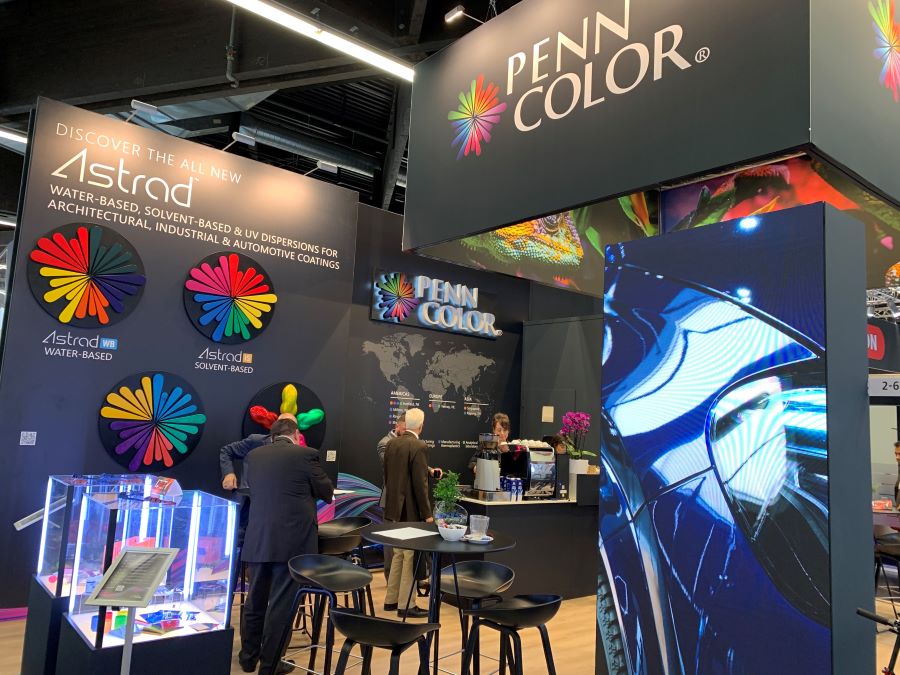 The Penn Color booth at ECS.
The Penn Color booth at ECS.
The new Astrad product portfolio of water-based, solvent-based, and UV dispersions includes four different series:
• Astrad-WB is a low/no-VOC, APEO-free, binder-free, water-based pigment dispersion. It offers high pigment loading, tight tolerances of shade and color for exact color reproduction, wide product compatibility.
• Astrad-UV is available in 100% solids in a variety of monomer systems. It is a sustainable solution, offering low energy curing, wide compatibility, and various degrees of functionality to ensure optimal performance.
• Astrad-IS is available as a broadly compatible acrylic resin system, with high pigment loading and optimal rheological properties. It is exceptional for universal tinting of solvent-based industrial coatings.
• Astrad-AUTO is available in a wide variety of single pigment dispersions covering the spectrum of automotive-grade colors, with high chroma and crystal-clear transparency. It provides the highest level of flexibility for paint formulators, with both solvent and waterborne dispersions. Astrad-AUTO can be used in both basecoats and mid-coats, for dynamic color effects.
SI Group's Expanded Coatings Portfolio
SI Group, a leading global performance additives company, exhibited its key coatings brands, including its REZICURE™ cobinder solutions, REZILITE™ light stabilizers, and ETHANOX™ antioxidants. This comprehensive range of additive and resin solutions provides customers with the means to optimize their coatings properties and better deliver products that meet today’s market demands including performance and safety.
SI Group is a well-established player in the can and metal coatings sector, and continues to invest in serving the broader coatings industry. In addition to recently expanding its portfolio of high-performance additives and resins for coatings, the company opened two new state-of-the-art laboratories dedicated to coatings research and development located in India and the United States. “SI Group has been serving the coatings sector for over 30 years, and we’re excited to be leveraging that experience to deliver new innovations for our customers,” said Jacek Gediga, SI Group’s Sr. Market Development Manager, Coatings. "We are attending ECS with our growing portfolio of solutions to increase awareness of SI Group's robust capabilities,” he added.
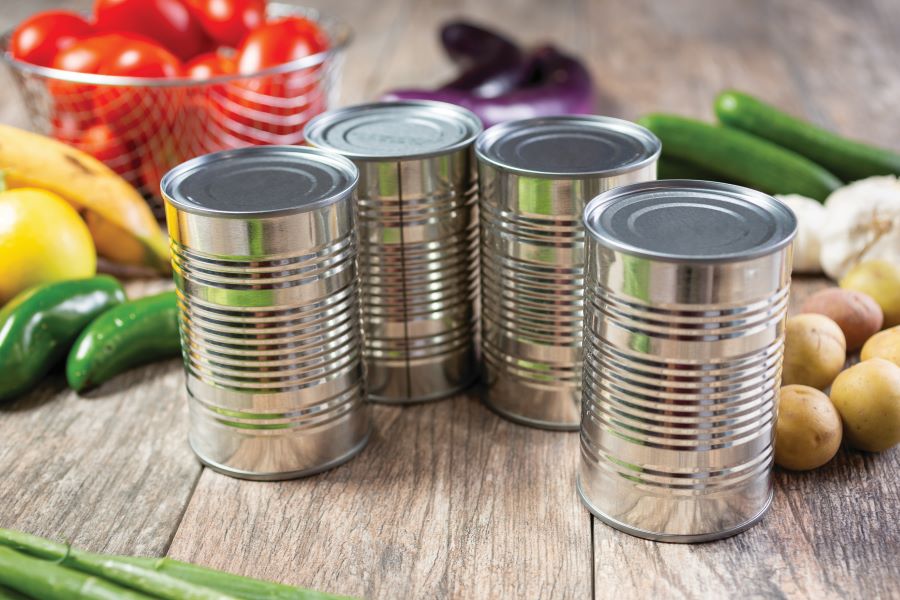 Image courtesy of SI Group.
Image courtesy of SI Group.
“A key attribute of modern coatings solutions is sustainability. It is important to our customers, business partners, and employees. As such, we strive to create a more sustainable future through our careful product development and stewardship,” said Chuck Reardon, Vice President, Industrial Solutions, at SI Group. “Our REZICURE brand line, for example, includes products that are biobased and are suitable for BPA-NI coatings systems. This not only supports our customers as they seek out more sustainable technologies but also demonstrates SI Group’s growing commitment to sustainability following the launch of our innovative EVERCYCLE™ additives for plastics recycling in 2022.”
Other product lines in SI Group's extensive coatings offering include resins, solvents, UV absorbers, and key chemical intermediates.
Solvay's Latest Advancements in Surfactants, Emulsifiers and Specialty Monomers
Solvay highlighted how its advanced surfactants, emulsifiers, specialty monomers, and other functional solutions can enhance the performance, aesthetics and lifetime of paints and coatings, while contributing to resource efficiency, improved air quality and healthier living.
The company presented the latest innovation in its growing family of Rhodoline® functional additives: Rhodoline WA-2830E, an Ecolabel, APE-free, low-VOC and low-SVOC, multifunctional performance additive for both interior and exterior waterborne coatings. Rhodoline WA-2830E provides superior water, scrub and block resistance. In addition, the new additive offers improved color acceptance and can reduce TiO2 without affecting opacity. With this unique combination of properties, Rhodoline WA-2830E can also minimize formulation costs.
“We’re excited to help our customers continue the shift to waterborne formulations and discuss solutions to their unmet needs through innovations such as our new wetting and dispersing agent, and reactive surfactant technologies, which further enhance our broad solutions portfolio aligned with today’s demanding performance and sustainability requirements,” explained Sel Avci, Global Coatings Marketing Director for Solvay’s Novecare global business unit.
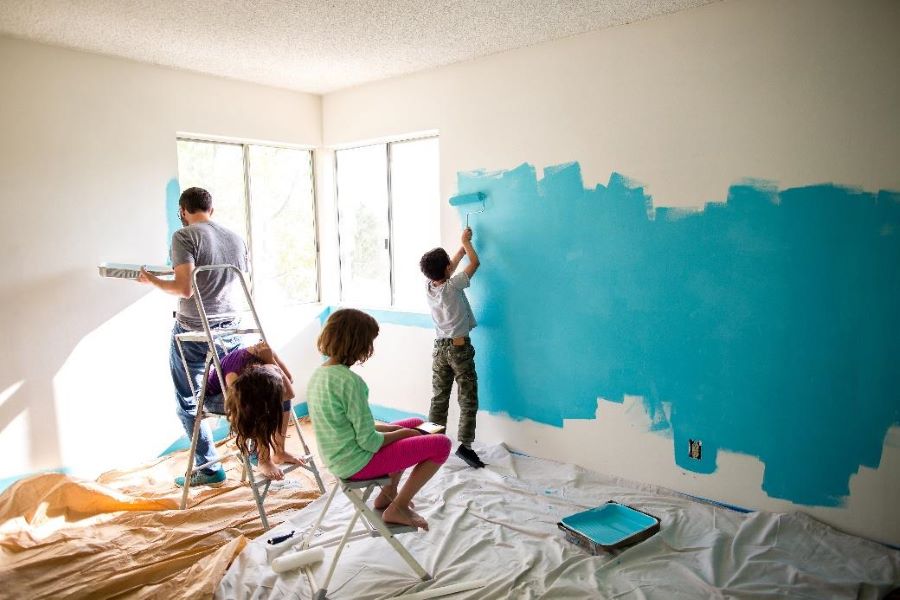 Image courtesy of Solvay.
Image courtesy of Solvay.
Solvay solutions in the spotlight at ECS 2023 included:
• Reactsurf® 2490 – a new APE-free polymerizable surfactant designed as a primary emulsifier for acrylic, vinyl-acrylic and styrene-acrylic latex systems, delivering superior dirt pick-up resistance in exterior coatings and water whitening resistance in pressure sensitive adhesives.
• Sipomer® PAM 600 – a multifunctional monomer, providing excellent anti-corrosion properties and adhesion on metals, glass and other inorganic substrates, as well as improved stain resistance and opacity in architectural coatings.
• Blanc Fixe – a multifunctional extender based on barium sulfate chemistry that enhances anticorrosion properties while improving hiding power and tint strength in both architectural and industrial coatings.
• Rhodasurf®, Abex®, and Aerosol® – APE-free, low-VOC and low-odor additives for waterborne coatings as well as biodegradable and partially biobased solutions, serving various functional needs in emulsion polymerization and in the formulation of paints and coatings.
• A wide range of oxygenated solvents, including Augeo® SL 191, an eco-alternative to petrochemical solvents, made from glycerin, a renewable source, for use in paints, varnishes and printing inks, where it offers low odor and excellent solubility.
• Addibond™ – polymeric additives enhancing the adhesion properties of conversion coatings formulations while meeting strict regulatory standards.
SONGWON Showcases Its Coatings Strength
SONGWON Industrial Group continues to demonstrate its firm commitment to the coatings industry with the expansion of its comprehensive portfolio of high-performance coatings products and blends. At the ECS, SONGWON launched the newest additions to its growing portfolio. Its new liquid UV absorber, SONGSORB® CS 171, is manufactured in SONGWON’s dedicated facility, Suwon in South Korea. It brings the advantage of being easily incorporated and can improve the stability of coatings and adhesive systems over time leading to higher performance. SONGSORB CS 171 can be used on its own or in blends such as SONGSORB CS B 5075.
SONGWON also launched its two newest blends, SONGSORB CS B 5438 and SONGSORB CS B 5452 for easy processing, a new stabilizer package for epoxy systems as well as a new solid triazine UV absorber. Developed especially for 2K PU clear coatings, SONGWON’s latest liquid blends are also suitable for use in water-based coatings systems. Both blends are characterized by their low initial color and excellent long-term protection. Compared to the benchmark used in the industry, the blends require fewer critical product labels because they use less hazardous formulation materials which also improves occupational safety.
To support demanding application areas that need epoxy systems, SONGWON introduced a new preblended, all-in-one liquid package used for general and for white/bright pigmented epoxy systems. The most recent addition to SONGWON’s existing portfolio of synergistic systems, SONGSORB CS B 5459 offers highly convenient processing and use, and also boosts the performance of the current systems. In addition to this, the release of its newest solid triazine, SONGSORB CS 1164, specially developed for coatings applications such as powder and liquid as well as adhesives and sealants, underpins SONGWON’s focus on high-performance UV systems.
“This year’s ECS was the most successful one for us. It gave us the chance to introduce several new products and blends and also emphasize the quality and value of the other products in SONGWON’s extensive portfolio,” said Rosanna Telesca, Leader Business Unit Coatings.
“After four long years, seeing our booth full of customers and partners and having such constructive and fruitful meetings which brought lots of new ideas and potential projects was really great. Our ECS success is a confirmation of the team’s hard work and dedication to SONGWON’s business in this industry and highlights the responsibility we all feel towards our customers and distributors,” she added.
Trinseo's Expanded Portfolio of Latex Binder Solutions
Trinseo showcased its portfolio of all-acrylic, styrene acrylic, and styrene butadiene latex binder innovations. Several newly launched latex binder solutions were on display that solve key performance and sustainability challenges for the building & construction, and adhesives industries.
Trinseo’s latest future-oriented solutions help customers meet their sustainability needs while designing differentiated products that address industry megatrends:
Competitive solutions for building and construction to increase efficiency include:
• LIGOS™ C 3013 and C 3343 binders for 1K waterproofing membranes;
• LIGOS M 3000 and M 3010 binders for 2K cementitious applications;
• LIGOS S family for classical to high-performance sealants;
• High-performance solutions for adhesives to lower total VOC emissions;
• LIGOS A 3003 and A 3009 binders for flexible or rigid packaging lamination;
• LIGOS A 3215 for PSAs for high shear resistance requirements;
• LIGOS A and C innovations for demanding construction adhesives, such as flooring and ceramic tile mounting.
More sustainable solutions helping companies on their journey to net zero carbon emissions include:
• CO2NET™ for at least 50% proven CO2 reduction compared to fossil-based equivalents while maintaining key performance properties.
"As the world focuses on supporting circularity, Trinseo is concerting efforts within the value chain and advancing new solutions designed to positively impact life and the environment while delivering on performance,” said Arthas Yang, CASE Global Business Director. “Products that carry our new CO2NET designation are proven, with scientific tools such as Life Cycle Assessment (LCA) or Product Carbon Footprint Assessment (PCF), to have a carbon emission reduction greater than 50% over their virgin, fossil-based equivalent.”
Univar's Innovations in Sustainable Coatings and ‘The House that CASE Built’
Univar Solutions unveiled ‘The House that CASE Built’, an interactive, intuitive experience featuring the company’s strong and growing portfolio of materials - including natural and sustainable ingredients, used for coatings and many other CASE market end products that can be found in the average home.
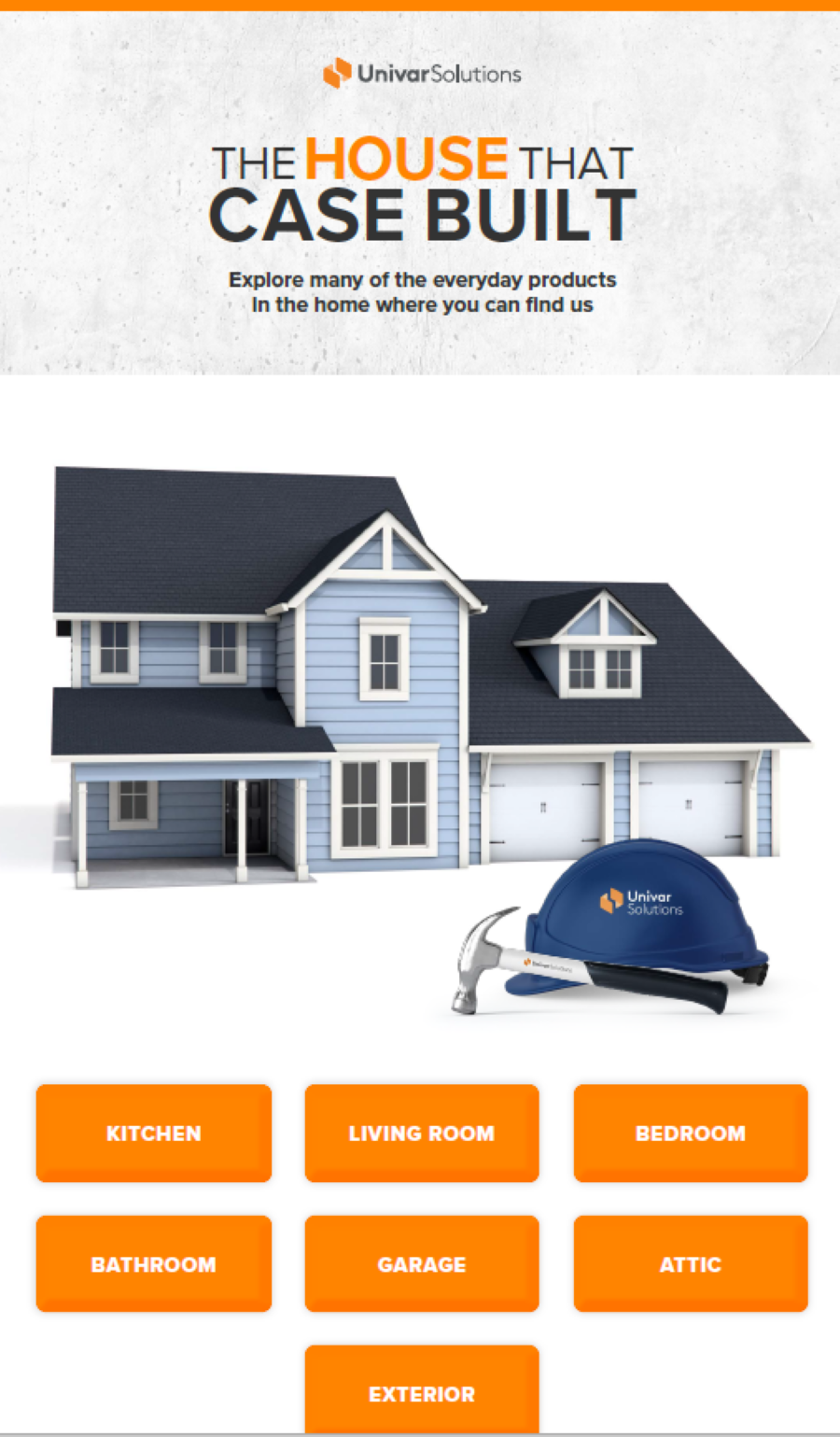 Image courtesy of Univar Solutions.
Image courtesy of Univar Solutions.
As innovative coating industries look to reduce VOCs and develop more environmentally friendly coatings for architectural, automotive, construction, or other specialized industrial markets, Univar Solutions is bringing sustainable coating technologies and innovations forward. Laboratory and technical experts at company Solution Centers—including its flagship Center in Essen, Germany, use their expertise in sustainable chemistries and raw materials to prepare specialty formulation solutions that help customers meet their performance, sustainability, and budget goals.
The company can help customers meet a wide range of application needs, including:
• APEO-free/APE-free;
• White reflective roof coatings;
• High-performance maintenance coatings;
• Low VOC;
• High-solids coatings.
Univar has identified and can share key technical considerations and supply chain issues customers will need to know to get started or continue their sustainability journey. For profitable growth in the green coatings market, customer sustainability considerations should include:
• Reduction/elimination of toxics such as ammonia, formaldehyde, odor masking agents, fungicides, and VOCs;
• Recycled content;
• Alternative paints and coatings materials;
• Durability;
• Packaging and circularity.
WACKER's Innovative and Sustainable Solutions for the Construction and Coatings Industries
WACKER presented a wide range of product and application highlights. Novelties being presented for the first time were binders for high-temperature coatings and high solids, silicone additives for silicate interior wall paints, dispersible polymer powders for tile adhesives, polymer dispersions for waterproofing membranes, and a silicone resin binder for stone carpets.
With over 300 square meters of booth space and a new trade show design, the company’s booth was easy to find. A few steps away from the booth, company chemists and technical service engineers were on hand at the WACKER Academy Forum to discuss the latest product and development trends in the construction, paints, coatings and sealants industries. Nearly 30 presentations were given over the three days of the show, sustainability being a focus of most talks. And it was here that WACKER hosted the press for presentations and demonstrations about the new products introduced at ECS.
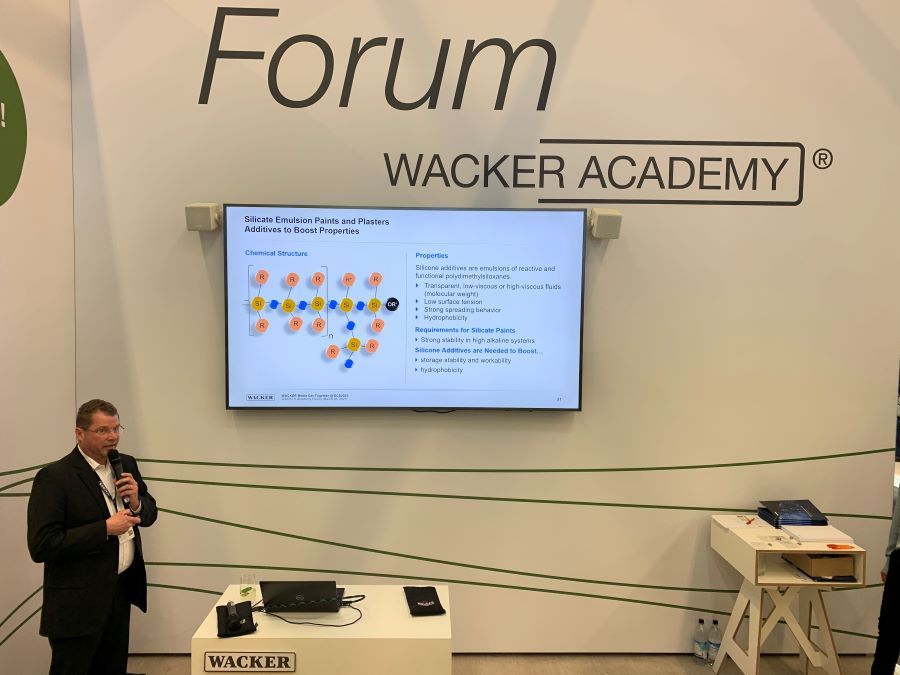 WACKER technical experts introduced several new products to the press at their booth.
WACKER technical experts introduced several new products to the press at their booth.
WACKER’s Silicones division also focused on sustainable solutions for the construction and coatings industries: resource-conserving silicone sealants (ELASTOSIL® eco), silicone resins for solvent-free high-temperature coatings, and silicone additives for biocide-free interior wall paints were among the highlights displayed this year. “Sustainability is a key concern for us as a company,” emphasized Robert Gnann, Head of the WACKER Silicones division.
WACKER showcased 10 new products at this year’s ECS. These include:
• Two New Silicone Resins for Water- and Solvent-Based Systems for High-Temperature-Resistant Coatings
SILRES® M 51 E is a functional methyl silicone resin finely dispersed as tiny droplets in an aqueous medium. Using this kind of formulation for application on metal substrates is novel. The properties of water-based paints in which SILRES M 51 E is the sole binder are similar in quality to those of heat-resistant coatings containing solvent-based silicone resin binders. Aqueous paint formulations dry quickly and, after baking, possess exceptional chemical and mechanical strength. Following thermal stress, such coatings show excellent color and gloss resistance.
SILRES IC 900 was designed as a binder for solvent-based paints and coatings that need to withstand high temperatures. The product, which consists of an alkoxy-functionalized methyl phenyl silicone resin, is delivered as a pure, undiluted active ingredient. Its low viscosity also enables the development of high-solids coatings. The resin is characterized by a molecular structure that, when crosslinked, results in a close-meshed network that still exhibits a certain flexibility. That flexibility prevents cracks from forming in the cured coating layer, especially under conditions of thermal stress. It follows that SILRES IC 900 makes it possible to produce coatings that can be applied in thick layers.
• Polymer Resin Binder Enhances Coating Properties of High-Solids and UV-Curing Coatings
WACKER also unveiled a new polymer resin binder to formulate solventborne coatings, printing inks, high-solids, and UV-curing systems. Development of the product started with VINNOL® H 40/43, an existing polymer resin grade that is suitable for a wide range of solvents and UV monomers. In VINNOL L-6868, the mixing ratio of vinyl chloride and vinyl acetate was modified. The outcome is a decisive improvement in solubility that renders VINNOL L-6868 highly soluble in ketones as well as in esters, acrylic monomers, UV monomers and glycol esters. The combination of modified polymer composition and very low molecular weight has the effect of substantially lowering the viscosity of the polymer resin. The new binder can be used to formulate high-solids systems, i.e. those with high pigment and binder contents. VINNOL L-6868 is also suitable for reactive curing systems.
• Silicone Additive for Waterborne Silicate Paints and Brush-on Plasters
WACKER showcased a new silicone additive for formulating silicate paints and brush-on plasters for interiors. This product, which is available as an aqueous emulsion under the name SILRES BS 338, facilitates processing of the coating materials, increases their storage stability and enhances the properties of the applied coating. Wall paints and brush-on plasters produced with the silicone additive have the same breathability as before, but yield a hydrophobic, water-repellent finish.
Wanhua Chemical's Advanced Solutions with Enhanced Sustainability
Wanhua Chemical Group Co. Ltd. presented technical talks on four innovative coating solutions. The sustainable development of these solutions helps to advance the coating industry’s ambitious environmental goals, and demonstrates the company’s commitment to green chemical processes, energy efficiency, emissions reduction, and the incorporation of recycled and bio-based materials.
Wanhua Chemical’s strong focus on sustainability is an important facet of its history of innovation and customer centricity. Since opening up the coatings business in 2013, the company has continually developed new products to meet changing industry needs. These initiatives include actively promoting the conversion of traditional oil-based coatings to water-based formulations and developing bio-based products, while helping customers improve production efficiency and cost-effectiveness.
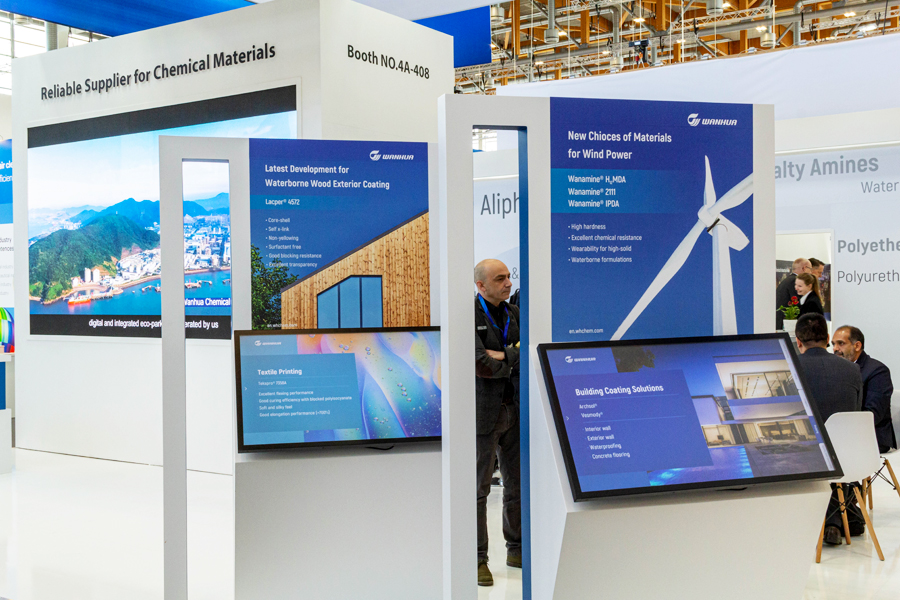 Image courtesy of Wanhua Chemical.
Image courtesy of Wanhua Chemical.
“We are supporting the coating industry’s sustainability trend by proactively developing new or enhanced products with a low carbon footprint,” stated Dr. Weiqi Hua, Executive Vice President, Wanhua Chemical. “Our experts work with downstream customers to formulate solutions that reduce environmental impacts while delivering high performance. By leveraging the breadth and depth of our portfolio and our full supply chain, we can help customers achieve their objectives – even in the face of increasingly stringent environmental regulations and strong competitive pressures.”
Wanhua Chemical presented on the following products during the event:
• Wanamine® H12MDA cycloaliphatic diamine for waterborne systems: This workhorse product has been successfully adapted for first time use in water-based epoxy coatings. It can extend the coating life cycle by more than 20 percent, even when exposed to VHD batch ovens, and it exhibits enhanced resistance to solvents such as ketones and organic acids.
• Waterborne coatings for polyurethane (PU) flooring: Marketed under the Archsol® and Aquolin® brands, this new two-component solution provides excellent resistance to chemicals, abrasion, wear and weathering, while greatly reducing VOC content. They offer a sustainable alternative to solvent-based PU coatings.
• Waterborne exterior coating for wood: High-end, soap-free Lacper® 4572 polyacrylic coating features low VOC. It complies with relevant EU KOMO test standards and provides extended protection for wood in outdoor environments. With a clear appearance and small particle size, this coating showcases the natural texture of wood.
• Aliphatic isocyanate crosslinker for PU coatings: Developed for two-component PU coatings, the Wannate® HT Series crosslinkers can reduce the viscosity of the coating system while retaining excellent performance, including chemical and scratch resistance.
Westlake Epoxy's New AZURES™ Systems
Westlake Epoxy launched its new AZURES product range at the ECS. These newly developed epoxy resins, modifiers, and curing agents are free of any SVHC- and CMR-labelled substances. As such, they provide better sustainable alternatives to existing technologies used in coatings, civil engineering, and adhesives while keeping the same level of performance.
“This is definitely another important milestone in Westlake Epoxy’s strategy to contribute to a safer and cleaner world,” said Ann Frederix, Vice President, Westlake Epoxy.
Recently, Westlake Epoxy’s European business also confirmed its receipt of the 2022 Platinum Medal from EcoVadis, the world’s largest and most trusted provider of business sustainability ratings, and Westlake Epoxy’s Pernis, Netherlands site has successfully passed the audit for its International Sustainability & Carbon Plus (ISCC+) certification.
Westlake Epoxy serves a variety of industries including adhesives, aerospace, automotive, civil engineering and construction, composite and wind energy, electronics, electric laminates and marine and protective coatings.
X-Rite's Color Measurement Solutions for a Sustainable Workflow
X-Rite Incorporated and Pantone LLC showcased the latest color measurement solutions for a sustainable workflow. X-Rite highlighted how paint and coating manufacturers can accelerate color formulation, ensure an accurate color match, avoid color rejections, and improve customer satisfaction. The company’s connected color solutions standardize digital color communications for designers, paint producers, and OEMs, ensuring the specified color is achieved on any substrate.
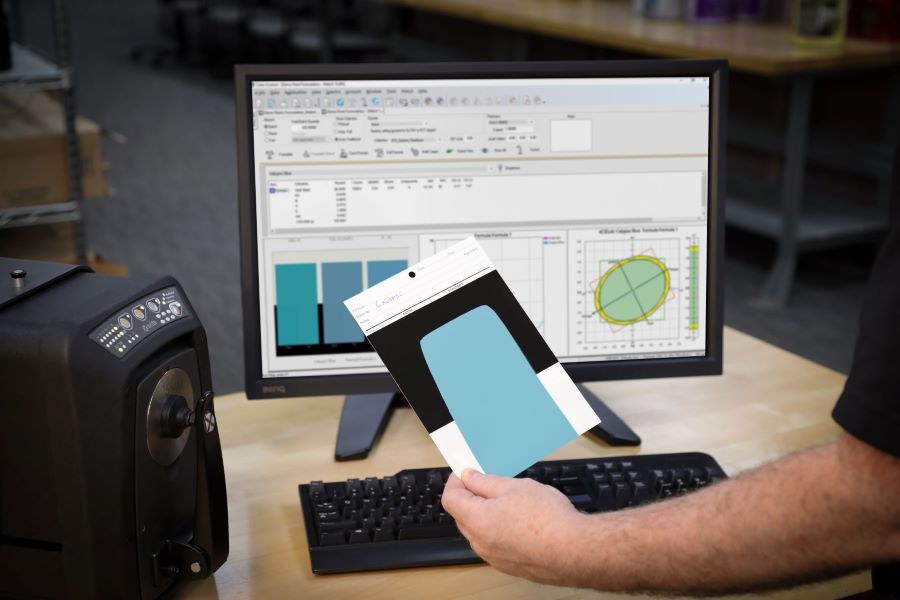 Image courtesy of X-Rite.
Image courtesy of X-Rite.
“Climate change has accelerated the paint and coatings industry’s move towards digitization and reducing carbon footprints,” said Matthew Adby, Product Management Director, X-Rite. “At ECS, attendees can see advanced color measurement technology designed to make it easier to capture precise color data and digitize it across their workflow. Customers can communicate accurate expectations, create virtual prototypes, efficiently formulate colorants by optimizing pigments, control color quality, and track data for conformity and continuous improvement. This leads to reduced waste, rework, and a sustainable workflow.”
X-Rite displayed color measurement solutions for every stage of the design to production process, including design and specification, virtual prototyping, formulation, production and quality control, and retail paint solutions.
This is just a small snapshot of the technology on display at the ECS this year. It is clear that coatings suppliers are laser-focused on developing products that will help coatings formulation, their manufacturing process, and usage be more sustainable.
Looking for a reprint of this article?
From high-res PDFs to custom plaques, order your copy today!




